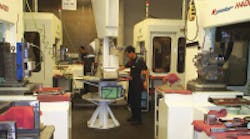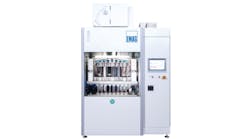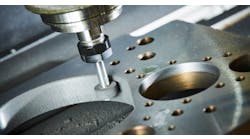By Preston J. McCreary
The best way to reduce machining lead time is to establish a “flow” from one process to another, using cells to link, synchronize, and eliminate excessive material handling, excess inventory, and excess labor costs.
Photo courtesy of B&B Manufacturing Co.
Many manufacturing companies (especially those that have machining or fabrication as a major portion of their processes) believe they are taking the lean journey by using one or two tools from the Lean Flow toolbox: 5S, TPM, setup reduction, material kanban, calculating takt time, or reducing batch sizes. Lean Flow is much more than using just a few of these tools.
Machine-based processes are a significant part of many manufacturing companies. Very few domestic manufacturers are just assembly operations. Those jobs went to low-cost countries where labor is cheap. Companies with machine-based processes used to have an edge at keeping their jobs, because of the cost barrier to move, train, maintain, and find experienced talent to run machine tools in a place like China. This made the U.S. companies appear globally competitive. That advantage is diminishing quickly; some would say it has vanished.
Only a few years ago, U.S. manufacturers with machining as a principal activity would have thought it unfeasible to relocate these operations to low-cost countries. Today, new plants are being established in the Far East (in China, mainly) for all types of products: bearings, electrical distribution components, and aerospace products. You name it, there is a company contemplating producing it in China. We can throw up our hands and say, “there is nothing we can do to change this trend,” or we can do something about it.
Does Toyota manufacture cars in low-cost countries like China, Malaysia, or Indonesia in order to sell them in the United States? No, those cars are made in the United States or Japan.
But, those facilities are high labor-cost operations. So how can Toyota do it? It uses the principles of Lean Flow manufacturing to produce products to reduce labor hours, reduce non-value-adding waste, put the supply chain on a pull, and use all of the tools in the Lean Flow toolbox to reduce the costs in the high wage locations to be competitive.
So what do U.S. companies have to do to stay competitive in the global economy? First and foremost, stop insisting “We are different,” or “You don’t understand the complexity of our products/designs/processes,” or “We are already doing lean with our 5S program.” It is time to use all of the tools in the Lean Flow toolbox to keep these manufacturing jobs in the United States and the rest of the western world.
Machines and Lean
How does a machine-based company implement lean? Not by doing the same things the same way as Toyota. The tools needed are the same or similar, but they need to be used differently, with different emphases in most U.S. manufacturers. Why? Because most U.S. manufacturers cannot control mix and volume as well as an automaker can. Most non-automotive companies do not have the volume to build highly automated, high-volume production facilities like the automotive companies. Therefore, Lean Flow tools will be implemented differently in companies outside the automotive industry.
Lean Flow in a machining environment is all about reducing lead-time, improving on-time delivery performance, eliminating waste, and reducing costs. As a result of these improvements, inventory is reduced, and a company should take market share from its competitors.
The best method for reducing lead time in a machining world is to get products to flow from process to process, using cells as the tool to link, synchronize, and eliminate all the waste of excessive material handling, excess inventory, and excess labor costs. With the reduced lead time and a pull-based materials system, on-time delivery performance will reach new levels. Through the focus on the elimination of waste, costs will be reduced, further improving the ability to compete in the global marketplace.
Lean Flow in a machine-based company is the creation of machine cells linked together through engineered queues. The cells are created around families of products or components and are designed to reduce lead time dramatically. The focus on the reduction of lead time drives all of the process/factory design decisions. The entire implementation process strives to achieve 50-99% reductions in lead-time.
Why the focus on lead-time? Long lead times drive large amounts of work in process (WIP) and/or finished goods inventory (FGI). A four-week lead time from first machining to a finished product ready for shipment means there will be at least four weeks of inventory in the process, and most likely more than four weeks of finished goods. Long lead times mean that manufacturing is neither flexible nor agile, and therefore cannot respond quickly to changes in demand. This aggravates on-time delivery issues, and may lose customers and sales.
With long lead times, there are more products/components in process and therefore more material at risk of quality defects, and more difficulty getting meaningful feedback to the processes creating the defects. Long lead times affect productivity as measured by the factory sales dollars per employee hour paid (not the efficiency of a particular machine operation on a particular part number). Productivity can be measured many ways; almost all of them will be negatively impacted by lost sales due to poor on-time delivery.
Machine cells also compel companies to use more of the Lean Flow tools in the toolbox than the few listed above. Lean Flow cell design groups the correct processes together into cells. The response from some companies to redesign the factory by creating machine cells is, “We are like a job shop environment so we never have the same product/component in the same quantity.” It is true for some companies, but many companies make the same components or types of components over and over. Even a job shop has certain types of components or machine processes that are repeated often.
The solution is to recognize the issues, understand the products and components, determine from history what the processes are for the families of products to be made, and create the flow of the processes required to produce products. A family might be round things made from bar stock, or round things made from castings/forgings, or prismatic shapes requiring horizontal machining centers, or assembly/pack cells, or …
How do we determine the correct machines to group together in a machine cell? Using a Lean Flow factory design process, the cells are designed around products or part numbers that have process commonality. These product families also use many of the same processes. Based upon the Lean Flow mathematical calculations, the correct types and number of machines and supporting processes are included in the cell design.
The graphic above shows a portion of a machining process for making bearing components. The machines were originally in a functional arrangement: all of the lathes together in an area, all of the machine centers in another area, with no division or separation of the machines into cells. After the implementation process, it was determined that the number of machines shown would be required to handle future volume. Also, within this large cell are smaller cells of 2-3 machines that allow the correct products to flow from machine to machine, and allow operations to be performed on sequential machines, versus on a single machine. This new arrangement often allows one-piece flow, dramatic lead-time reductions, less WIP, and a more responsive, flexible set of processes.
Special Issues with Machines
There will be many variations or potential issues to be resolved in a machine cell design process. If there are shared processes between potential cells, the cell with the highest utilization of that process should hold the shared process. Then the other cells send demand to that cell as required.
It is preferred that the shared process be co-located so the cells can easily share the process, enabling a good flow in and out of the shared process. Often, a plant will have an underutilized process available that can substitute for the shared process in one cell, thus eliminating the need to share the process and disrupt the flow. The Lean Flow implementation team uses mathematical formulas to determine the size and physical design of the queues for products feeding the shared cell from many different other cells – sometimes all at once.
Many machine-based companies have batch processes like plating, painting, heat treating, and degreasing, which require large quantities of a product/component to be processed together. These processes often end up as singular cells, with other cells feeding product to the batch process. Then, the batch cell will send the product on to the appropriate downstream cells for final processing. With many different cells sending materials to these batch cells, the management of the queues on either side of the batch processes become critical to maintaining FIFO, grouping like processing requirements together (common heats, paint colors, common plating processes, etc.), and keeping inventory to a minimum without exploding costs.
A Lean Flow implementation will most likely have to deal with the oddball products/components that require an operation for a machine in another cell, or operations in many different cells. This is usually a small portion of part numbers that will not be ideal for the flow through the cells. It is normally the exception, not the rule. Enjoy the benefits provided by the cell for the majority of products and suffer through the exceptions. The design of the Lean Flow process in the machine cells establishes rules for dealing with these exception products and minimizing the negative impacts.
In the second installment of this series, we will discuss the need for productivity improvements, how to achieve those productivity improvements and additional Lean Flow tools to be used when implementing in a machine-based company.
Also Read: Productivity, Performance and Machines
Preston J. McCreary is a consultant and partner with FlowVision LLC. Contact him at [email protected], or tel. 303-886-2852.






